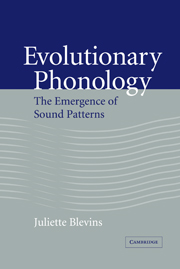2 - Evolution in language and elsewhere
Published online by Cambridge University Press: 22 September 2009
Summary
It is a natural principle that the script and the sounds of language differ according to time and place.
Chén Dì (1541–1617)Darwin's (1859) theory of the evolution of life forms has been used as a metaphor for historical developments in other fields almost since its conception. Darwin himself made use of the language-equals-species comparison, and this has continued in the modern field of linguistics, being most apparent in the field of historical linguistics. Mother languages develop, split into daughter languages, which in turn develop and split, much like the speciation of biological organisms. As biological organisms become extinct, languages also die, never to be heard again. The gradual change of languages in isolation in contrast to abrupt shifts which may occur through social contact have been likened to the punctuated equilibrium characteristic of biological evolution (Thurston 1987). Environmental conditions leading to linguistic diversity, including richness of natural resources and geographic isolation, are similar to those associated with extreme localism and higher rates of speciation in life forms. And, reflecting the similarities between models of genetic inheritance and those of language change, the trees used to represent linguistic relationships have a similar form and interpretation to those used in modern cladistics. A mother node (e.g. Proto-Indo-European) defines a genetic family of languages, with daughter nodes (Indo-Iranian, Balto-Slavic, Germanic, etc.) defined by shared linguistic innovations.
However, it has long been recognized that language change differs in significant ways from biological evolution, and that comparisons between the two systems must remain metaphorical.
- Type
- Chapter
- Information
- Evolutionary PhonologyThe Emergence of Sound Patterns, pp. 25 - 60Publisher: Cambridge University PressPrint publication year: 2004



